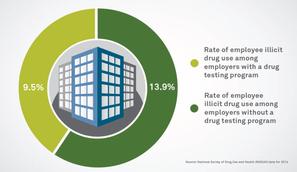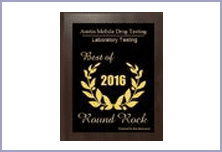Smoked
- Peak: 0-30 minutes
- High experience: 1-3 hours
- Effects return to baseline: 3-6 hours
- Residual effects: Up to 24 hours
A zero-tolerance policy should be necessary for safety

Yes. In fact organizations with high employee absenteeism rates (more than 15%), the implementation of a drug testing program appears to have an impact. 9% of organizations reported high absenteeism rates (>15%) prior to a drug testing program, whereas only 4% of organizations reported high absenteeism rates after the implementation of a drug testing program, a decrease of approximately 50%.
Nearly one fifth (19%) of organizations experienced an increase in productivity after the implementation of a drug testing program.
Employee turnover rates decreased nearly one-fifth (16%) in organizations after the implementation of drug testing programs.
The National Institute of Drug Addiction has reported that 10% of employees use drugs in the workplace and that someone who abuses drugs will function at about 67% capacity.
Approximately 90 percent of employees with a drug/alcohol problem work for small or medium sized companies.
The liability of NOT having a Drug Free in the Workplace could cost YOU business!
REMEMBER: Drug abusers KNOW which Employer's DO NOT drug test and so the Employer typically hires drug abusers without knowing it!
Don't be Short-Sided and say "I don't care what they do on their days off"...drug abusers do not leave their abuse at home or leave it at the door when they arrive to work. Companies that do not have a Drug Free Workplace are proven to pay higher insurance premiums than Companies that do.
Setting up a policy for pre employment and random testing your employees for substance abuse can save cots from loss of productivity, theft, accidents, absenteeism, increased costs for worker's compensation and healthcare benefits, and the increased costs of liability insurance premiums.
DOT FREQUENTLY ASKED QUESTIONS:
HOW MUCH TIME DO I HAVE TO GET TESTED?
Once a Driver is Notified, he/she MUST go Immediately to the Collection Site.
If you are the DER (Designated Employer Representative)
- You have the Selection Period to Complete the Random Testing.
- Once you notify a Driver, he/she MUST go immediately to the Collection Site.
- 1st quarter ends March 31st / 2nd quarter ends June 30th / 3rd quarter ends September 30th and 4th quarter ends December 31st.
WHY ARE MY DRIVERS ALWAYS SELECTED!
- Austin Mobile Drug Testing makes Computerized Random Selections.
- Drivers have an equal chance of being selected each quarter.
- Drivers could be selected every quarter or go a year without being selected.
- We have no control over who is selected.
- Austin Mobile Drug Testing Consortium must guarantee the DOT that 25% of the average number of drivers are tested for Drugs and 10% are tested for Alcohol for the year.
A Driver may be selected 0-4 times each year. DOT requires drivers that complete their pre-employment testing to be in the random pool and eligible for random selections.




